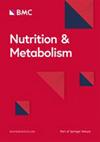重新审视血脂与维生素 K 代谢之间的相互联系:最新研究的启示和潜在的治疗意义:综述
IF 3.9
2区 医学
Q2 NUTRITION & DIETETICS
引用次数: 0
摘要
维生素 K 是一种亲脂性维生素,其吸收、运输和分布都受到脂质的影响。补充维生素 K 后的血浆维生素 K 水平主要受血脂影响,与现有的维生素 K 状态无关。然而,以往有关维生素 K 补充剂疗效的研究往往忽略了血脂水平对维生素 K 吸收的影响,导致结果不一致。最近的研究发现,尿毒症患者体内维生素 K2 在尿毒症高密度脂蛋白(HDL)中的运输功能受损,这可能解释了在慢性肾病患者中补充月桂醌-7(MK-7)的多项试验中观察到的维生素 K2 对预防钙化无益的现象。临床研究结果表明,用于调节高脂血症的药物会与维生素 K 拮抗剂华法林相互作用,因为胆固醇和维生素 K 在肠细胞和肝细胞中具有共同的转运受体,如 Niemann-Pick C1-like 1 (NPC1L1) 和 ATP 结合盒蛋白 G5/G8 (ABCG5/ABCG8)。此外,胆固醇和维生素 K 有一个共同的生物合成中间体,称为儿茶酚羟基焦磷酸(GGPP)。值得注意的是,他汀类药物会阻碍胆固醇的合成,也会阻碍维生素 K 的转化,最终影响依赖维生素 K 的蛋白质的功能。此外,一些研究表明,补充维生素 K 有助于控制高脂血症,这为利用膳食维生素 K 补充剂控制高脂血症开辟了一条新途径。因此,更全面地了解维生素 K 与血脂之间错综复杂的相互作用,将对维生素 K 的利用和血脂调节产生宝贵的启示。本文章由计算机程序翻译,如有差异,请以英文原文为准。
Revisiting the interconnection between lipids and vitamin K metabolism: insights from recent research and potential therapeutic implications: a review
Vitamin K is a lipophilic vitamin, whose absorption, transportation, and distribution are influenced by lipids. The plasma vitamin K level after supplementation is predominantly a lipid-driven effect and independent of existing vitamin K status. However, previous studies examining the efficacy of vitamin K supplementation often overlooked the influence of lipid levels on vitamin K absorption, resulting in inconsistent outcomes. Recent research discovered that impaired transportation of vitamin K2 within uremic high-density lipoproteins (HDL) in individuals with uremia might elucidate the lack of beneficial effects in preventing calcification observed in multiple trials involving menaquinone-7 (MK-7) supplementation among patients with chronic kidney disease. Clinical findings have shown that drugs used to regulate hyperlipidemia interact with the vitamin K antagonist warfarin, because cholesterol and vitamin K share common transport receptors, such as Niemann-Pick C1-like 1 (NPC1L1) and ATP-binding cassette protein G5/G8 (ABCG5/ABCG8), in enterocytes and hepatocytes. Additionally, cholesterol and vitamin K share a common biosynthetic intermediate called geranylgeranyl pyrophosphate (GGPP). It is important to note that statins, which hinder cholesterol synthesis, can also impede vitamin K conversion, ultimately impacting the functionality of vitamin K-dependent proteins. Furthermore, certain studies have indicated that vitamin K supplementation holds potential in managing hyperlipidemia, potentially opening a novel avenue for controlling hyperlipidemia using dietary vitamin K supplements. Therefore, attaining a more comprehensive understanding of the intricate interplay between vitamin K and lipids will yield valuable insights concerning the utilization of vitamin K and lipid regulation.
求助全文
通过发布文献求助,成功后即可免费获取论文全文。
去求助
来源期刊

Nutrition & Metabolism
医学-营养学
CiteScore
8.40
自引率
0.00%
发文量
78
审稿时长
4-8 weeks
期刊介绍:
Nutrition & Metabolism publishes studies with a clear focus on nutrition and metabolism with applications ranging from nutrition needs, exercise physiology, clinical and population studies, as well as the underlying mechanisms in these aspects.
The areas of interest for Nutrition & Metabolism encompass studies in molecular nutrition in the context of obesity, diabetes, lipedemias, metabolic syndrome and exercise physiology. Manuscripts related to molecular, cellular and human metabolism, nutrient sensing and nutrient–gene interactions are also in interest, as are submissions that have employed new and innovative strategies like metabolomics/lipidomics or other omic-based biomarkers to predict nutritional status and metabolic diseases.
Key areas we wish to encourage submissions from include:
-how diet and specific nutrients interact with genes, proteins or metabolites to influence metabolic phenotypes and disease outcomes;
-the role of epigenetic factors and the microbiome in the pathogenesis of metabolic diseases and their influence on metabolic responses to diet and food components;
-how diet and other environmental factors affect epigenetics and microbiota; the extent to which genetic and nongenetic factors modify personal metabolic responses to diet and food compositions and the mechanisms involved;
-how specific biologic networks and nutrient sensing mechanisms attribute to metabolic variability.
 求助内容:
求助内容: 应助结果提醒方式:
应助结果提醒方式:


